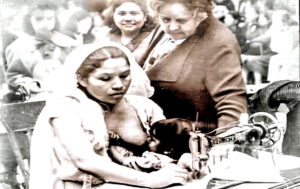
A 1957 Snapshot of Maternal Labor, Empowerment, and Indigenous Resilience in Rural Mexico
A poignant 1957 photograph captures seamstress instructor María Dolores Méndez guiding Guadalupe Soqui López, an Indigenous woman from rural Mexico, as she learns to operate a Singer sewing machine while breastfeeding her child. This powerful image transcends time, embodying the struggles and triumphs of women in mid-20th-century Mexico, where gender roles, poverty, and cultural barriers shaped daily life.
The Scene: Dual Struggles of Motherhood and Labor
In the photograph, Guadalupe Soqui López, a member of Mexico’s Indigenous communities, balances two acts of survival: mastering a skill to uplift her family and nurturing her infant. The Singer sewing machine—a symbol of industrial progress and women’s entry into skilled labor—anchors the frame. María Dolores Méndez, likely part of post-revolutionary Mexico’s grassroots education initiatives, represents solidarity, offering Guadalupe tools to navigate a patriarchal, economically strained society. The image, taken during Mexico’s milagro económico (economic miracle) era, contrasts the nation’s urban growth with rural realities, where Indigenous women faced limited access to education and formal employment.
Historical Context: Indigenous Women and Economic Shifts
In 1950s Mexico, only 38% of women were literate, with rates lower in Indigenous regions. Government programs aimed to integrate rural communities into the economy, often through vocational training. The Singer machine, introduced in Mexico in the late 1800s, became a lifeline, enabling home-based garment work a trade dominated by women. For Guadalupe, mastering it meant potential income while adhering to maternal duties, a common tightrope for Indigenous mothers. María’s mentorship underscores the era’s informal networks of female empowerment, where skills were passed down outside formal institutions.
Symbolism: Sacrifice and Silent Resistance
Guadalupe’s act of breastfeeding while learning challenges stereotypes of Indigenous passivity. Her multitasking embodies triple jornada (triple workday): childcare, labor, and household management. The photograph rejects victimhood, instead of highlighting dignity in resilience—a theme echoed in later feminist movements. María’s calm guidance reflects the unsung role of female educators in Mexico’s development, bridging urban progress and rural tradition.
Legacy: A Testament to Unseen Labor
This photograph, rediscovered in archives, has become a cultural artifact, referenced in studies on gender and labor. It predates second-wave feminism but aligns with its principles: economic independence as liberation. For Indigenous women like Guadalupe, sewing offered autonomy without uprooting cultural identity—a delicate balance still relevant today.
Modern Parallels: Empowerment Through Craft
The image resonates in Mexico’s craft cooperatives, where Indigenous artisans blend traditional techniques with modern tools. Organizations like Fondo Semillas continue María’s legacy, providing resources to women in marginalized communities. Meanwhile, the Singer machine remains iconic; vintage models are displayed in museums as emblems of women’s labor history.
Conclusion: An Ode to Everyday Heroism
This 1957 photograph immortalizes more than a moment—it honors generations of Mexican women who turned humble tools into instruments of change. María Dolores Méndez and Guadalupe Soqui López’s story is one of a quiet revolution, where skill-sharing and maternal love converged to defy adversity. As Mexico grapples with gender inequality and Indigenous rights, their image reminds us that empowerment often begins in the most unassuming places: a thread threaded, a stitch sewn, a child fed.
María Dolores Méndez, Guadalupe Soqui López, 1957 photograph, Singer sewing machine, Indigenous women Mexico, rural Mexico mid-20th century, maternal labor, women’s empowerment, Mexican seamstress, gender roles 1950s, Indigenous resilience, post-revolutionary Mexico, vocational training, economic miracle Mexico, women’s labor history, breastfeeding and work, Indigenous artisans, cultural artifact, Fondo Semillas, silent resistance.
